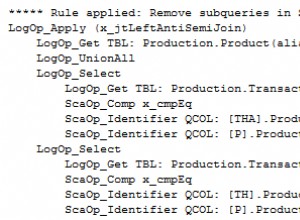PostgreSQL में ऐसा करने के एक से अधिक तरीके हैं। निजी तौर पर, मैं इस तरह से पसंद करता हूं।
-- This table should contain all the columns common to both
-- audio books and printed books.
create table books (
isbn char(13) primary key,
title varchar(100) not null,
book_type char(1) not null default 'p'
check(book_type in ('a', 'p')),
-- This unique constraint lets the tables books_printed and books_audio
-- target the isbn *and* the type in a foreign key constraint.
-- This prevents you from having an audio book in this table
-- linked to a printed book in another table.
unique (isbn, book_type)
);
-- Columns unique to printed books.
create table books_printed (
isbn char(13) primary key references books (isbn),
-- Allows only one value. This plus the FK constraint below guarantee
-- that this row will relate to a printed book row, not an audio book
-- row, in the table books. The table "books_audio" is similar.
book_type char(1) default 'p'
check (book_type = 'p'),
foreign key (isbn, book_type) references books (isbn, book_type),
other_columns_for_printed_books char(1) default '?'
);
-- Columns unique to audio books.
create table books_audio (
isbn char(13) primary key references books (isbn),
book_type char(1) default 'a'
check (book_type = 'a'),
foreign key (isbn, book_type) references books (isbn, book_type),
other_columns_for_audio_books char(1) default '?'
);
-- Authors are common to both audio and printed books, so the isbn here
-- references the table of books.
create table book_authors (
isbn char(13) not null references books (isbn),
author_id integer not null references authors (author_id), -- not shown
primary key (isbn, author_id)
);




